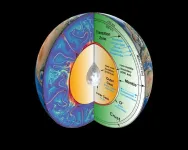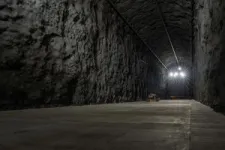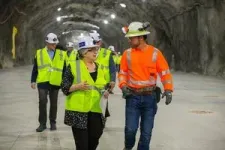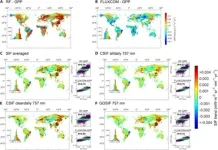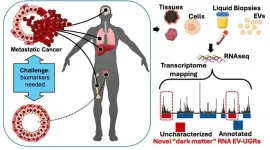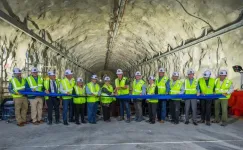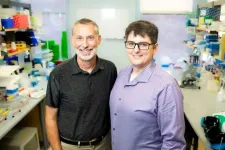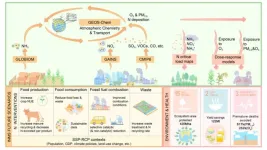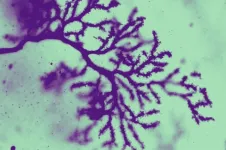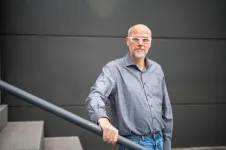(Press-News.org) For the decades since their discovery, seismic signals known as PKP precursors have challenged scientists. Regions of Earth’s lower mantle scatter incoming seismic waves, which return to the surface as PKP waves at differing speeds.
The origin the precursor signals, which arrive ahead of the main seismic waves that travel through Earth’s core, has remained unclear, but research led by University of Utah geophysicists sheds new light on this mysterious seismic energy.
PKP precursors appear to propagate from places deep below North America and the western Pacific and possibly bear an association with “ultra-low velocity zones,” thin layers in the mantle where seismic waves significantly slow down, according to research published in AGU Advances, the American Geophysical Union’s lead journal. (The AGU highlighted the research in its magazine Eos.)
“These are some of the most extreme features discovered on the planet. We legitimately do not know what they are,” said lead author Michael Thorne, a U associate professor of geology and geophysics. “But one thing we know is they seem to end up accumulating underneath hotspot volcanoes. They seem like they may be the root of whole mantle plumes giving rise to hotspot volcanoes.”
These plumes are responsible for the volcanism observed at Yellowstone, the Hawaiian Islands, Samoa, Iceland and the Galapagos Islands.
“These really, really big volcanoes seem to persist for hundreds of millions of years in roughly the same spot,” Thorne said. In previous work, he also found one of the world’s largest known ultra-low velocity zones.
“It sits right beneath Samoa, and Samoa is one of the biggest hotspot volcanoes,” Thorne noted.
For nearly a century, geoscientists have used seismic waves to probe Earth’s interior, leading to numerous discoveries that would not be otherwise possible. Other researchers at the U, for example, have characterized the structure of Earth’s solid inner core and tracked its movement by analyzing seismic waves.
When an earthquake rattles Earth’s surface, seismic waves shoot through the mantle—the 2,900-kilometer-thick dynamic layer of hot rock between Earth’s crust and metal core. Thorne’s team is interested in those that get “scattered” when they pass through irregular features that pose changes in material composition in the mantle. Some of those scattered waves become PKP precursors.
Thorne sought to determine exactly where this scattering happens, especially since the waves travel through Earth’s mantle twice, that is, before and after passing through Earth’s liquid outer core. Because of that double journey through the mantle, it has been nearly impossible to distinguish whether the precursors originated on the source-side or receiver-side of the ray path.
Thorne’s team, which included research assistant professor Surya Pachhai, devised a way to model waveforms to detect crucial effects that previously went unnoticed.
Using a cutting-edge seismic array method and new theoretical observations from earthquake simulations, the researchers developed, they analyzed data from 58 earthquakes that occurred around New Guinea and were recorded in North America after passing through the planet.
“I can put virtual receivers anywhere on the surface of the earth, and this tells me what the seismogram should look like from an earthquake at that location. And we can compare that to the real recordings that we have,” Thorne said. “We’re able to now back project where this energy’s coming from.”
Their new method allowed them to pinpoint where the scattering occurred along the boundary between the liquid metal outer core and the mantle, known as the core-mantle boundary, located 2,900 kilometers below Earth’s surface.
Their findings indicate that the PKP precursors likely come from regions that are home to ultra-low velocity zones. Thorne suspects these layers, which are only 20 to 40 kilometers thick, are formed where subducted tectonic plates impinge on the core-mantle boundary in oceanic crust.
“What we’ve now found is that these ultra-low velocity zones do not just exist beneath the hotspots. They’re spread out all across the core-mantle boundary beneath North America,” Thorne said. “It really looks like these ULVZs are getting actively generated. We don’t know how. But because we’re seeing them near subduction, we think mid-ocean ridge basalts are getting melted, and that is how it’s getting generated. And then the dynamics is pushing these things all across Earth, and ultimately they’re going to accumulate beneath the hotspots.”
“What we’ve now found is that these ultra-low velocity zones do not just exist beneath the hotspots. They’re spread out all across the core-mantle boundary beneath North America,” Thorne said. “It really looks like these ULVZs are getting actively generated. We don’t know how. But because we’re seeing them near subduction, we think mid-ocean ridge basalts are getting melted, and that may be how they’re getting generated.”
The dynamics is pushing these things all across Earth, and ultimately, they’re going to accumulate against the boundaries of Large Low Velocity Provinces, which are compositionally distinct continent scale features beneath the Pacific and Africa, according to Thorne.
“They may additionally accumulate beneath the hotspots, but it is unclear if these ULVZs are generated by the same process,” he said. Determining the consequences of such a process will have to wait for future research.
#####
The study, “Investigating Ultra-Low Velocity Zones as sources of PKP scattering beneath North America and the Western Pacific Ocean: Potential links to subducted oceanic crust,” was published in the August edition of AGU Advances. Co-authors include Surya Pachhai, now a research assistant professor in the U’s Department of Geology & Geophysics. This research, funded by the National Science Foundation, was conducted in collaboration with geoscientists at Arizona State University and University of Leeds in the U.K.
END
A recent study has pinpointed the top-performing solar-induced chlorophyll fluorescence (SIF) products for precise global monitoring of photosynthesis and vegetation dynamics. By thoroughly evaluating eight widely-used SIF datasets, the research team identified Global OCO-2 SIF (GOSIF) and Contiguous Solar-Induced Fluorescence (CSIF) as leading tools for estimating gross primary productivity (GPP) and forecasting key phenological stages. These findings provide crucial direction for scientists aiming to enhance global vegetation ...
New York, NY [August 16, 2024]—Scientists at the Icahn School of Medicine at Mount Sinai have identified a new class of RNAs packed into tiny particles known as extracellular vesicles (EVs) that could revolutionize how cancer and other diseases are diagnosed. The team found that these molecules undergo changes when cancer is present, suggesting their potential as biomarkers for detecting prostate cancer or as targets for therapy. The work, led by Navneet Dogra, PhD, Edgar Gonzalez-Kozlova, PhD, Tzu-Yi Chen, PhD, ...
Lead, SD (Aug. 15, 2024) — A ribbon-cutting event was held today at the Sanford Underground Research Facility (SURF) in Lead, S.D. to mark the completion of excavation work for the Long-Baseline Neutrino Facility/Deep Underground Neutrino Experiment (LBNF/DUNE), an international project led by the U.S. Department of Energy’s Fermi National Accelerator Laboratory. The “Into the Depths of Discovery” event, hosted by Fermilab and the South Dakota Science and Technology Authority (SDSTA), was attended by supporters of the three-year excavation of the caverns, including state and federal leaders as well as officials from the Department of Energy.
“Today ...
Third-party collection of mail-in ballots has helped rural residents and those with disabilities to vote, yet the practice has become contentious and the target of laws aimed at restricting it.
Critics claim the process is vulnerable to fraud and manipulation.
But new research from the University of Utah’s College of Social & Behavioral Science tells a different story. Ballot collection is more accurately characterized as a pathway for legitimate voter participation, according to a study published last month. Authors Daniel McCool, a professor emeritus in the Department of Political Science, and Weston McCool, a ...
James Tour’s lab at Rice University has developed a new method known as flash-within-flash Joule heating (FWF) that could transform the synthesis of high-quality solid-state materials, offering a cleaner, faster and more sustainable manufacturing process. The findings were published in Nature Chemistry on Aug. 8.
Traditionally, synthesizing solid-state materials has been a time-consuming and energy-intensive process, often accompanied by the production of harmful byproducts. But FWF enables gram-scale production of diverse compounds in seconds while reducing energy, water consumption and greenhouse gas emissions by ...
Inherited diseases of metabolism and immunity have more in common than previously recognized, according to a new study published in the journal Science Immunology. The findings point to a new set of metabolic genes that are important for the function of immune system T cells, and they offer insights that could improve care for patients with these disorders.
The study examined genes that cause inborn errors of metabolism (disorders of the processes that cells use to convert food to energy) and inborn errors of immunity (disorders that affect immune system function). These rare and complex diseases are not fully understood.
“There had previously ...
The Earth’s nitrogen cycle is among the most heavily exceeded planetary boundaries. Agricultural production and fossil fuel burning release nitrogen pollutants like ammonia (NH3), nitrogen oxides (NOx), and nitrous oxide (N2O), which contribute to air pollution and damage ecosystems. These pollutants harm human health, crops, and ecosystems. Given the growing global energy and food demand, this damage is expected to increase even further.
The potential of nitrogen pollution mitigation technologies ...
More than 70 genes have been linked to autism spectrum disorder (ASD), a developmental condition in which differences in the brain lead to a host of altered behaviors, including issues with language, social communication, hyperactivity, and repetitive movements. Scientists are attempting to tease out those specific associations gene by gene, neuron by neuron.
One such gene is Astrotactin 2 (ASTN2). In 2018, researchers from the Laboratory of Developmental Neurobiology at Rockefeller University discovered how defects in the protein produced by the gene disrupted ...
The European Union's law on artificial intelligence came into force on 1 August. The new AI Act essentially regulates what artificial intelligence can and cannot do in the EU. A team led by computer science professor Holger Hermanns from Saarland University and law professor Anne Lauber-Rönsberg from Dresden University of Technology has examined how the new legislation impacts the practical work of programmers. The results of their analysis will be published in the autumn.
'The AI Act shows ...
Imagine having to do your job, but not being able to visually process the data right in front of you. Nearly eight percent of genetic males and half a percent of genetic females have some form of Color Vision Deficiency (CVD), or the decreased ability to discern between particular colors. CVD is commonly referred to as color blindness.
Scientists use colors to convey information. Many scientists in the weather radar community have CVD and the use and interpretation of color is an important aspect of their work. Most colormaps ...
